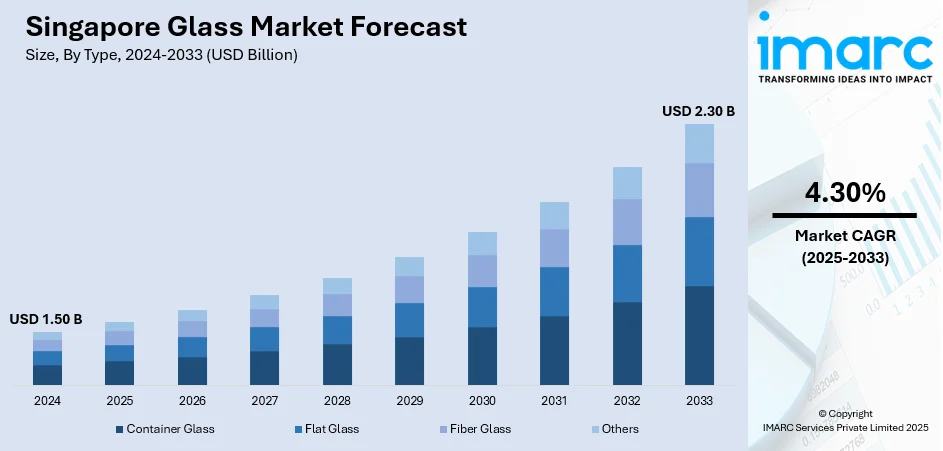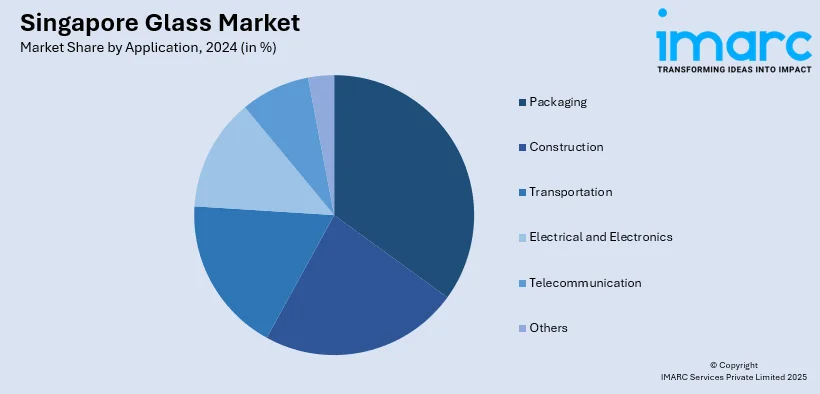
Singapore Glass Market Size, Share, Trends and Forecast by Type, Application, and Region, 2025-2033
Singapore Glass Market Size and Share:
The Singapore glass market size reached USD 1.50 Billion in 2024. Looking forward, IMARC Group expects the market to reach USD 2.30 Billion by 2033, exhibiting a growth rate (CAGR) of 4.30% during 2025-2033. The market is experiencing steady growth driven by government initiatives for green buildings and infrastructure projects facilitating the need for energy-efficient glass products, the integration of automation and AI in production enhancing quality, and continuous technological advancements in manufacturing.
|
Report Attribute
|
Key Statistics
|
|---|---|
|
Base Year
|
2024
|
|
Forecast Years
|
2025-2033
|
|
Historical Years
|
2019-2024
|
| Market Size in 2024 | USD 1.50 Billion |
| Market Forecast in 2033 | USD 2.30 Billion |
| Market Growth Rate (2025-2033) | 4.30% |
Singapore Glass Market Trends:
Technological advancements in manufacturing
Advancements in manufacturing technologies are leading to growth in the Singapore glass market. Rising demand for smart glass, which can alter its properties according to environmental conditions, and efficient glazing systems are enabling the development of advanced use cases. These innovations help in stabilizing and offering green materials in building & construction, which the sector demands and continues to grow to be more eco-friendly. For instance, in September 2024, AGC Group earned Cradle to Cradle Certified® Bronze for its flat and coated glass products in Asia, meeting sustainability criteria and supporting Green Building Certifications like LEED and WELL. Therefore, this is significantly supporting the market. Automation and AI are also integrated into manufacturing processes to increase precision and reduce production costs for high-quality glass products to be more affordable. Moreover, with the implementation of cutting-edge coating methods, the strength and functionality of glass are enhanced enabling its deployment in the automotive, electronics, and healthcare sectors.

To get more information on this market, Request Sample
Growing construction and infrastructure development
The accelerating construction and infrastructural development of Singapore is propelling the market. The escalating demand for tempered, laminated, and insulating glass as well as other architectural glass products, is stimulated by government programs and private investment in residential, commercial, and industrial construction projects. Along with this, the growing focus on green buildings and sustainable urban development is also helping intensifying the market growth, as glass is essential for energy efficiency and provides aesthetic appeal. In addition, the use of advanced glass solutions is also on the rise, partially due to innovations in smart building technologies. For instance, in February 2024, Glaston unveiled a new process for manufacturing triple TPS® insulating glass units with ultra-thin center glass (0.5mm), enhancing window efficiency while simplifying the replacement process. Such initiatives are contributing to the growing demand for different glass products as part of Singapore's holistic urban planning, which is based on higher-density and mixed-use developments.
Increasing demand for solar glass
The increasing efforts to shift towards renewable energy resources are favoring growth in solar glass in Singapore. With the country targeting sustainability to decrease carbon emissions, solar glass found an application in photovoltaic panels, which has gathered momentum. This is being driven by both the government's effort to enhance solar capacity and incentives to adopt renewable energy solutions. Solar glass used in construction and infrastructure projects ensures energy efficiency and creates a sustainable environment. Its appeal is bolstered by developments in solar glass, such as greater transparency and better light transmission, as well as better energy conversion efficiencies. For instance, in January 2024, Singapore surpassed halfway to its 2030 solar power target of 2,000 MW, with solar glass playing a key role in enhancing energy efficiency and meeting sustainability goals. Furthermore, the rising demand fits Singapore's wider objectives of strengthening national energy security and encouraging greener energy solutions, which is creating a positive market outlook.
Singapore Glass Market Segmentation:
IMARC Group provides an analysis of the key trends in each segment of the market, along with forecasts at the region level for 2025-2033. Our report has categorized the market based on type and application.
Type Insights:
- Container Glass
- Flat Glass
- Fiber Glass
- Others
The report has provided a detailed breakup and analysis of the market based on the type. This includes container glass, flat glass, fiber glass, and others.
Application Insights:

- Packaging
- Construction
- Transportation
- Electrical and Electronics
- Telecommunication
- Others
A detailed breakup and analysis of the market based on the application have also been provided in the report. This includes packaging, construction, transportation, electrical and electronics, telecommunication, and others.
Regional Insights:
- North-East
- Central
- West
- East
- North
The report has also provided a comprehensive analysis of all the major regional markets, which include North-East, Central, West, East, and North.
Competitive Landscape:
The market research report has also provided a comprehensive analysis of the competitive landscape. Competitive analysis such as market structure, key player positioning, top winning strategies, competitive dashboard, and company evaluation quadrant has been covered in the report. Also, detailed profiles of all major companies have been provided.
Singapore Glass Market News:
- Saint-Gobain announced signing of a definitive agreement to acquire Glass Service, a leading provider of digital solutions for glass furnaces. Glass Service, Inc. provides state-of-the-art control systems and simulation software prepared to allow customers to reduce their energy utilization. This acquisition is expected to close by the end of H1 2024.
- Singapore Institute of Technology announced that it is adoption AGC's photovoltaic glass for its new Punggol campus that is scheduled to be open in 2024. It is going to be the first campus in Southeast Asia to install an urban multi-energy microgrid that is expected to decentralize energy sources. It is also supposed to enable the effective use of local renewable energy sources, with the aim of obtaining the Super Low Energy (SLE) certification established by Singapore's Building and Construction Authority.
Singapore Glass Market Report Coverage:
| Report Features | Details |
|---|---|
| Base Year of the Analysis | 2024 |
| Historical Period | 2019-2024 |
| Forecast Period | 2025-2033 |
| Units | Billion USD |
| Scope of the Report |
Exploration of Historical Trends and Market Outlook, Industry Catalysts and Challenges, Segment-Wise Historical and Future Market Assessment:
|
| Types Covered | Container Glass, Flat Glass, Fiber Glass, Others |
| Applications Covered | Packaging, Construction, Transportation, Electrical and Electronics, Telecommunication, Others |
| Regions Covered | North-East, Central, West, East, North |
| Customization Scope | 10% Free Customization |
| Post-Sale Analyst Support | 10-12 Weeks |
| Delivery Format | PDF and Excel through Email (We can also provide the editable version of the report in PPT/Word format on special request) |
Key Questions Answered in This Report:
- How has the Singapore glass market performed so far and how will it perform in the coming years?
- What is the breakup of the Singapore glass market on the basis of type?
- What is the breakup of the Singapore glass market on the basis of application?
- What is the breakup of the Singapore glass market on the basis of region?
- What are the various stages in the value chain of the Singapore glass market?
- What are the key driving factors and challenges in the Singapore glass?
- What is the structure of the Singapore glass market and who are the key players?
- What is the degree of competition in the Singapore glass market?
Key Benefits for Stakeholders:
- IMARC’s industry report offers a comprehensive quantitative analysis of various market segments, historical and current market trends, market forecasts, and dynamics of the Singapore glass market from 2019-2033.
- The research report provides the latest information on the market drivers, challenges, and opportunities in the Singapore glass market.
- Porter's five forces analysis assist stakeholders in assessing the impact of new entrants, competitive rivalry, supplier power, buyer power, and the threat of substitution. It helps stakeholders to analyze the level of competition within the Singapore glass industry and its attractiveness.
- Competitive landscape allows stakeholders to understand their competitive environment and provides an insight into the current positions of key players in the market.
Need more help?
- Speak to our experienced analysts for insights on the current market scenarios.
- Include additional segments and countries to customize the report as per your requirement.
- Gain an unparalleled competitive advantage in your domain by understanding how to utilize the report and positively impacting your operations and revenue.
- For further assistance, please connect with our analysts.
 Request Customization
Request Customization
 Speak to an Analyst
Speak to an Analyst
 Request Brochure
Request Brochure
 Inquire Before Buying
Inquire Before Buying




.webp)




.webp)












